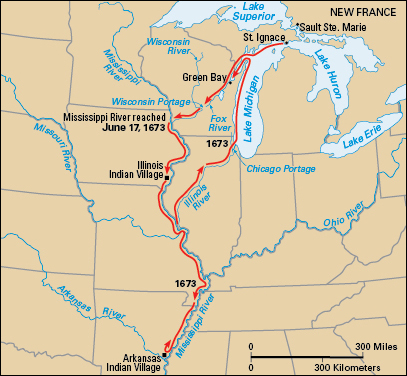Marquette, Jacques, << mahr KEHT, zhahk >> (1637-1675), was a French explorer and Roman Catholic missionary in North America. He joined the French-Canadian explorer Louis Jolliet on a trip down the Mississippi River. They were probably the first Europeans to explore the upper Mississippi and parts of Illinois and Wisconsin.
Early life.
Marquette was born on June 1, 1637, in Laon, France, and attended schools run by Jesuit priests. He joined the Jesuit order in 1656 and spent the next 10 years studying and teaching in France. In 1666, he was sent as a missionary to New France, the French empire in North America.
In New France, Marquette spent two years learning indigenous (native) languages. In 1668, he established a mission among the Ottawa people at Sault Sainte Marie in what is now Ontario. He went to the St. Esprit mission on Lake Superior in 1669 and worked among the Huron and Ottawa First Nations. In 1671, he moved with them to the St. Ignace mission on northern Lake Michigan.
Indigenous people often talked about a great river called the Mississippi, a word that meant big river in their language. At that time, little was known about the geography of North America. Marquette and others thought the river might flow into the Pacific Ocean.
Exploration and discovery.
Governor General Comte de Frontenac of New France believed the Mississippi might provide an easy route to the Far East for traders. In 1673, he sent Louis Jolliet to find the river and trace its course. Marquette knew some Native American languages, and so he was chosen to go with Jolliet. 
In May 1673, Marquette, Jolliet, and five other men set out in two canoes from St. Ignace. They paddled south on Lake Michigan, into the Fox River, and up through what is now Wisconsin. They traveled overland from the Fox to the Wisconsin River. At the mouth of the Wisconsin, they saw the Mississippi.
The explorers paddled down the Mississippi and realized that it flowed south. They decided that the river probably flowed into the Gulf of Mexico, rather than into the Pacific Ocean. Along the way, they met many friendly Native Americans. But when the men reached the mouth of the Arkansas River, they encountered hostile tribes. A Native American man told Marquette that white people lived farther south on the river. The explorers realized these people must be Spaniards who had settled along the Gulf of Mexico. Marquette and Jolliet feared that the Native Americans and Spaniards would attack them. Having learned the course of the river, they turned back.
The expedition traveled up the Mississippi to the Illinois River and from there to the Kankakee River. They journeyed overland from the Kankakee to the Chicago River and on to Lake Michigan. Their journey had taken about five months.
Final journey.
In 1674, Marquette set out from near present-day Green Bay, Wisconsin, to establish a mission among the Kaskaskia people near Ottawa, Illinois. But he became ill and spent the winter in a hut on the Chicago River. Marquette arrived in the spring of 1675, but his health became worse. He started out to St. Ignace for medical aid but died on the way, on May 18. A statue of Marquette represents Wisconsin in the United States Capitol in Washington, D.C.
